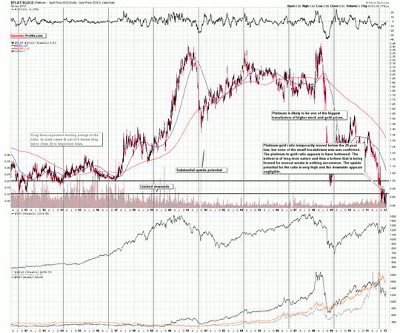The gold price surpassing that of platinum is an “anomaly” that makes platinum—which is the rarer of the two metals—a sparkling buy now, especially because this phenomenon is unlikely to persist for very long.
There are certain dogmas held sacrosanct by precious metals investors, and one of them is that platinum is supposed to be more expensive than gold. That’s just the way it is.
Quite a few eyebrows lifted and jaws dropped last fall when the yellow metal’s price overtook that of platinum. The historic switch took place on Sept. 2 when Comex gold futures settled at $1,875.25 per troy ounce, just above platinum’s closing price of $1,873 per ounce.
When you consider the price history of the two precious metals—platinum has traded at a $200-$400 premium to gold—the reversal was astounding. Just to give a better idea, before the 2008 Lehman Brothers crash, platinum was trading at more than $2,270 per ounce while gold was trading under $990 an ounce.
Platinum is much more rare in nature than gold. More than ten times more gold is mined each year than platinum. Unlike gold, which is either held in bank vaults or used in jewelry, more than 50% of the yearly production of platinum is consumed (used up) by industrial uses, mostly in the automobile industry. Some 40% is used for jewelry manufacturing and 10% for investment purposes.
The Japanese seem to be very fond of platinum as they account for 95% of the platinum jewelry demand. There are reports in the press of a nascent interest in platinum jewelry in India, expected to make up 25%-30% of the total Indian jewelry sales in 2012.
The annual supply of platinum is only about 130 tons, equivalent to only 6% (by weight) of the total annual gold mine production. It is less than one percent of silver’s yearly output. Unlike gold, there are no large inventories of above-ground platinum. Therefore, any breakdown in the two major supply sources, South Africa and Russia, would catapult the price of platinum.
See related: Platinum Has Room to Run
An even more intriguing fact is that more than 90% of the world’s platinum production comes from only four mines: three in South Africa and one in Siberia.
During economic expansion, platinum prices tend to outpace gold given its dual role as both a precious and industrial metal. But when the economy slows down, platinum can often stumble. For example, platinum dropped below the price of gold back in the early 1980s, pushing the spread below 1.0 for the better part of five years as the economy slowly recovered.
During the 2008 financial collapse, platinum prices fell from $2,252 to $774, a drop of nearly 65%. Both metals crashed. Gold nosedived due to hedge fund liquidations and investors dumped platinum bracing for a recession expected to flatten automobile sales. The metals reached parity in December 2008 as the price of platinum sunk amid the global financial crisis and a collapse in auto demand.
Gold has since has put on a show-stopping comeback, reaching a high of $1,900 last summer, but platinum has yet to bounce back. As this goes to publishing, the price of gold is $1,655 and the price of platinum is $1,515.
NEXT: Gold/Platinum Ratio Chart Shows This Rare Price Anomaly
|pagebreak|Let’s take a look at the chart featuring platinum. You will see platinum at the bottom of the chart below and the platinum/gold ratio on top:
On the above platinum/gold ratio chart (please click chart to enlarge), we see an anomaly unlike anything seen in recent years. There have been several small breakdowns below the level of previous lows, but none have held.
Platinum’s extreme undervaluation is not something that is likely to persist for much longer. The ratio is now at 0.92, and once it begins to move higher, much more platinum buyers are likely to enter the market.
Platinum’s price below that of gold is something that investors view as a buying opportunity (as seen on the above chart), so the only factor that remains in place that is preventing prices from moving higher is fear. Once fear subsides as investors see that platinum is not breaking lower, they will buy. This action will likely result in platinum soon outperforming gold once again; something that has not been seen for some time (except earlier this year).
Summing up, it appears that the situation in the platinum/gold ratio and for platinum itself is favorable, and if you’ve been planning to diversify your metals holdings, it might be a good idea to consider this particular metal.
See related: A “Once-a-Decade” Platinum Trade
By the Staff at SunshineProfits.com













